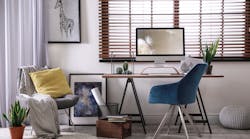Photo: Studies show that the average person utilizes only 40% of their livable area at home, so re-allocating space to accommodate the new work-from-home paradigm comes as a must rather than an option.
What began as a response to a global pandemic—remote working—is now a trend that is posed to stick around long after the pandemic subsides. The lifestyle change of the office-centric job becoming a thing of the past, is creating one of the biggest design movements of the year—a push to create new workspace at home.
This is a trend that is here to stay for the long-term as many studies predict that office life will not return to how it was before. To create a space for the modern worker, it is important to create an area that functions to fit the workers individual needs while being ascetically pleasing at the same time.
To start designing a productive at-home workspace, it is important to think about the basic functions and needs of the person who will be using that space. For example, the design industry is a collaborative, hands-on industry with many in-person meetings. As those meetings transitioned to be computer-based, it became important for designers to build a space in a location with strong internet connection and appropriate light balance to not skew how something appeared on the screen versus in-person.
At its core, the long-term trend of working from home underscores the need for space to function like it has never before, as the home is extending itself past its previous use.
It is important to separate the workspace from personal space, if your space accommodates this. At RODE Architects, we encourage this through designating a “work area” separate from your living space. If a wall partition is not accessible, physical separation ca be achieved by placing a movable screen where one face is a hard surface like marker board, and the other of a sound absorbent material like felt. This helps with speech privacy, physical and visual separation, as well as providing with vertical workspace.
[Related Podcast: Survey Explores How Working From Home Affects Designers]
Another way to create separation within a space is with live vegetation. Plants are not only aesthetically pleasing, but are an effective way to create just the right amount to visual separation within spaces. It also assists with lowering stress levels, filtering toxins and elevating the décor of a space, which ultimately assists with productivity.
Once the basic needs are met, interior design can be utilized to showcase the personality of the individual. For example, some trends we are seeing here include bringing back soothing and welcoming neutrals through materials which can help create a comfortable environment.
Crisp, soft white walls help brighten a space and make it feel larger than it is, while rich textured fabrics like leather and wool bring comfort and warmth. Medium and deep blues are making a comeback and will not disappoint. Using blue as an accent color can bring a space to life while being appropriately soothing for most audiences (Notably, Classic Blue has been named the Pantone color of the year.).
Further, we see this home office trend extending into new construction, as new builds will have dedicated office spaces more so than they have in the past. For multi-family units, we see communal spaces being reworked to accommodate this design movement as well. For example, with a current multifamily project in the Boston area, some typical unit layouts include an alcove office space, square footage that would otherwise be allocated to living space.
Studies show that the average person utilizes only 40% of their livable area at home, so re-allocating space to accommodate the new work-from-home paradigm comes as a must rather than an option.
Although many hope for the day when they can go back and meet in person, these newfound practices are effective and here to stay. As designers, our job is to problem solve, and times like these are the perfect opportunity to grow and evolve our practice, resulting in a much more elevated design and business experience from home.
Read Next: How Will Education Design Change in a Post-Pandemic Environment?
